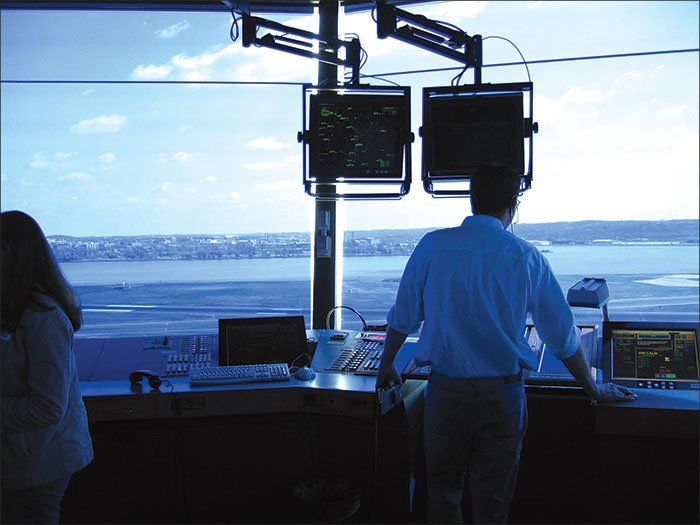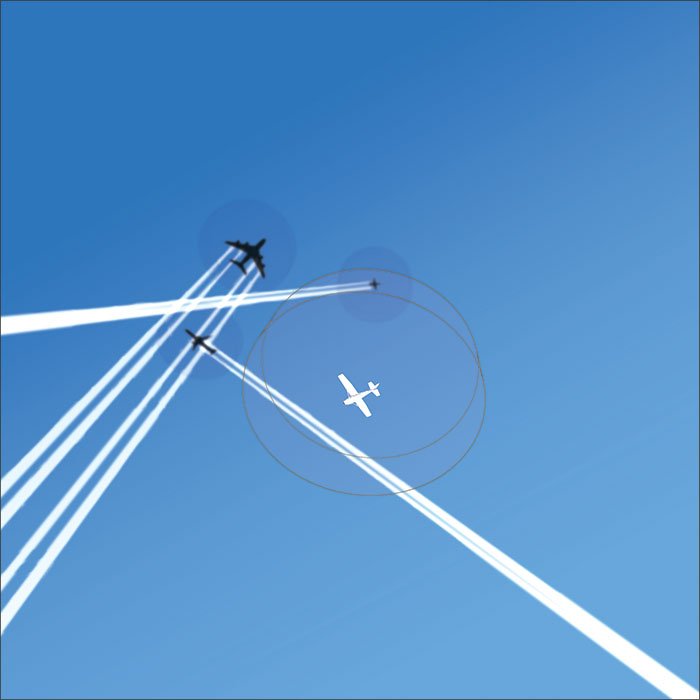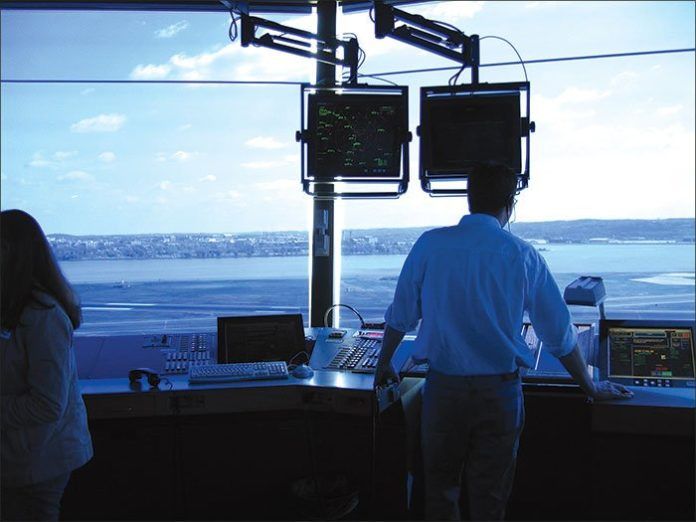Nutjob. That’s what we all called him. He was one of my trainers at my first tower. Extreme skydiving and off-the-grid adventure travel earned him the title. His not-safe-for-work “There I was…” stories were legendary throughout our ATC community.

Despite his off-campus reputation, he didn’t screw around in the control tower. He confidently ran his traffic tight. Was there an airplane-sized hole in the traffic flow? He’d shove an airplane into it, never compromising safety.
If you were smart, you took Nutjob’s advice when offered. The best chunk of knowledge he ever dropped on me summed up air traffic control’s complexity in a mere six words. As I was wrangling a sloppy pattern of Cessnas, Nutjob was sitting behind me, feet up on the console. As I struggled for my own mental footing, I heard his dry Southern rasp. “Just put ‘em where they ain’t.”
The light clicked. I’d been over thinking things. Behind the phraseology and regs, the mission was simple: ensure separation. Focusing on that task cleared my head. I reigned in my traffic.
Separate Aircraft
Controllers need to comply with a roughly five-pound book of regulations called FAA Order 7110.65. Chew through its government legalese, though, and you’ll find many of the spacing standards that ATC uses aren’t much more complex than Nutjob’s succinct statement. Controllers continuously use these standards to prevent aircraft from sharing the same piece of sky.
Common sense and good judgment form the foundation, but there are specific rules for specific types of air traffic facilities. Each affects how flexible ATC can be when handling your IFR flight.
ATC separation requirements are divided into two main categories: terminal and enroute. Terminals, of course, are places where aviation journeys begin and end. Not the building filled with waiting passengers and duty-free shops, of course, but a towered airport itself and any surrounding airspace that’s worked by an overlying terminal radar approach control (TRACON).
Picture these TRACONs as islands of airspace extending out around 40 or 50 miles. Their airspace typically tops at 10,000 feet, but can extend higher depending on local traffic flow needs. These TRACONs run off one or more short-range approach surveillance radars that have a 60 mile range and rotate every six seconds.
The wild ocean of air between and above those TRACON islands is operated by Air Route Traffic Control Centers (ARTCCs), or simply “Center” on-frequency. Centers are referred to as the “enroute environment” since they’re overseeing traffic that’s traveling in between the terminal islands. To keep track of their massive airspace, they use an overlapping network of long range radars that feature a 150 mile range and spin about once every 12 seconds.
Why do radar ranges and spin rates affect you? Controllers have to work within the limitations of their available technology. Different tech means different rules. With increasing distance and slower sensor spin rates comes reduced target resolution. The lower the target resolution, the more space ATC needs between those targets.
No Touchie
Control towers and TRACONs follow straightforward terminal rules: maintain 1000 feet of vertical separation or three miles of horizontal separation between all IFR aircraft. With some exceptions, if ATC maintains that “1-or-3” bubble around IFR traffic, life is good.
Vertical separation is already partially ensured just when pilots file a flight plan, when you use odd altitudes for eastbound flights and even altitudes for westbound ones. Stacking opposite direction traffic at 1000-foot intervals is a good start. As your flight progresses, ATC may adjust your cruising altitude to maintain your vertical spacing from traffic crossing or sharing your route.
Traffic crossing paths or running in parallel at the same altitude needs to be spaced by three miles. That naturally includes IFR aircraft climbing or descending through an altitude occupied by another nearby aircraft, hence the “vectors for climb” on departure and “vectors for descent” as you near your destination. Generally speaking, controllers don’t like disturbing aircraft when they’re established on course at their cruising altitude. Still, safety trumps convenience, and we won’t hesitate to issue “vectors for traffic” when needed, and “proceed on course” when the conflict is resolved.
ATC gets creative on a busy final approach course. A controller may have traffic of all types inbound to one or more runways, and he must line them up on final with at least three miles in trail. ATC may vector you through final “for spacing,” reduce your speed to minimum 10 miles from the airport, or keep you high on the localizer until a faster aircraft passes underneath. Frustrating? Sure, but the alternative is worse: being pulled off the final altogether and getting vectored “for re-sequencing.”
There are exceptions to the 1-or-3 rules. Sometimes, the spacing is decreased. Certain airports with approaches to parallel runways can run traffic with only 1.5 miles of diagonal spacing. Other exceptions, such as wake turbulence, increase the distance. Extra spacing is required when ATC vectors smaller aircraft behind large (max takeoff weight 41,000-255,000 pounds) or heavy ones (over 255,000 pounds).
Threading Needles
In dense terminal airspace, it’s tough to avoid popping that 1-or-3 bubble around every IFR arrival and departure. The solution is to cheat—legally—through a common sense thing called course divergence. If two aircraft depart the same position on headings that differ at least 15 degrees, they can never conflict. That “position” can be either an airport runway, or a point in space.
Picture yourself in a Cessna 172, holding short of Runway 9. You’ve got a Citation business jet waiting behind you. Tower clears you for takeoff on heading 070. As you lift and bear left, Tower launches the Citation on heading 090. You’re not even beyond the airport boundary when the Citation blazes past you in its climb. Did Tower have three miles or a thousand feet between you? Nope, but diverging headings ensured the Citation wouldn’t run you over.
Imagine the alternative, where Tower launched you both on the runway heading. The Citation would be delayed until you pedal your Cessna miles and miles away upwind before launching the jet, allowing enough room for departure to turn the fast mover off your tail. Intelligent use of course divergence means fewer (or shorter) delays for everyone. The ideal thing is to give you a diverging heading in the direction you want to go anyway, so you won’t need to cross back over the departure path.
The starting position doesn’t have to be an airport. It can be an aircraft’s current position. Imagine you’re still IFR in that Skyhawk, plugging along at 4000 feet, heading 270. Approach has a Columbia 400 overtaking you by 100 knots, behind and to your left, heading 285. Here, the starting point is your aircraft’s current position. The TRACON controller just needs to ensure the Columbia passes behind you. (If he passed in front of you, you’d be converging. That’s, you know, bad for safety and stuff.) Second, he needs to ensure your courses diverge by at least 15 degrees.
As long as the Columbia passes aft of your tail—even just a quarter mile away—and his northwest heading is at least than 285, ATC has achieved diverging courses and therefore separation.
Big Sky Country
The larger the air traffic facility, the further apart they need to run their aircraft. One reason is that centers use slower-turning long-range radars to watch over their massive airspace.
Imagine you’re driving on a crowded highway at 60 mph. To simulate a TRACON short range radar sweep, close your eyes for six seconds, then open them. You’ve blindly traveled 88 feet. That’s scary. Now, shut your eyes for a center’s 12 seconds. You’ve traveled twice as far—176 feet—without checking your position or that of other traffic.
Multiply your speed by 10 to 600 mph and picture yourself at 33,000 feet. That’s ten miles a minute. Shutting your eyes for 12 seconds means you’ve traveled two miles. That 12 second delay between traffic updates halves target position accuracy. If a plane turns or changes altitude unexpectedly, it takes twice as long for a center to realize what’s happening, thus more time to correct it.
To compensate, the center rules are more stringent. For aircraft sharing an altitude, enroute controllers are required to maintain five miles between all of their targets and cannot use course divergence. This applies to all IFR traffic in a center’s airspace, whether it’s United 768 cruising along at flight level 330, or the Cessna at 4000 feet.

Like terminals, centers use 1000 feet vertical spacing, but only up to FL270. Above FL270, they’re required to use 2000 feet between stacked planes, with the exception of aircraft that are qualified for Reduced Vertical Separation Minimum. RVSM-capable traffic only requires the original 1000-foot vertical separation.
ATC terminal facilities feeding aircraft to a center do so with enroute requirements in mind. TRACONs launching departures into a center’s airspace need to ensure five miles of separation will be achieved. Towers that aren’t paired with a TRACON and operate directly under a center’s oversight need to do the same.
Non-Radar
What if there’s no radar, such as in mountainous or oceanic areas? Welcome to the mysterious, spooky world of “non-radar” ATC. These controllers rely entirely on pilots for accurate position reporting, picturing aircraft positions in their heads and tracking them using a clock and paper flight plans. This is abstract stuff, even for other controllers who don’t work it often, and subject to the most restrictive separation requirements in all of ATC.
For example, IFR aircraft sharing an airway at the same altitude need to be a minimum of 20 miles in trail, or cross mandatory reporting points ten minutes apart. Are aircraft crossing a certain fix or departing the same airport? If the lead aircraft is 44 knots faster than the second one, they only need five miles or one minute. A 22-knot difference requires ten miles or five minutes. Non-radar is a complex mind game in practice, yet the goal is still simple: keep the aircraft separated.
Of course, with the dawning of the ADS-B age, requirements may change. ADS-B promises one second traffic updates for all ATC facilities using a mix of ground-based sensors and new GPS-enabled transponders. No sweeping radars required.
That could drastically change the game for en route operations. However, the 2020 adoption deadline for aircraft operators is still a ways away, the ADS-B sensor system is not yet fully installed, and the ATC system’s infrastructure is still not ready for the green light.
No matter the technology or the tools involved, the ATC concept stays the same. Ol’ Nutjob may have retired a couple years ago, but his legacy lives on. Whenever I’m training a new controller and they’re struggling a little bit, I muster up my most obnoxious southern accent and tell ‘em, “Just put ‘em where they ain’t.”

Mark 1 Eyeball
As good as radar is, nothing beats good vision. Aptly named “visual separation” regulations allow controllers to run airplanes tighter than radar alone.
The most obvious visual separation is pilot-provided. ATC issues traffic to you, the pilot. You report the other aircraft in sight. Then you’re told, “Maintain visual separation from that traffic.” You can save everyone a transmission and just say, “Traffic in sight. Will maintain visual separation.” The controller’s separation responsibility is ended. It’s up to you not to hit the other guy.
Tower controllers have the most flexibility. First, they can use the same radar rules as the radar facility overseeing them. But, inside their own limited airspace, they can put those big tower cab windows to use, grab some binoculars if needed, and visually ensure their airplanes aren’t running together.
Picture an IFR Gulfstream IV on a three-mile final to a 5000-foot runway. From the tower, I can see the GIV’s landing lights in the distance. I clear an IFR Cessna 310 for takeoff with runway heading. The C310 is about a half mile off the departure end when the GIV touches down. That mile and a half isn’t enough for any radar, but, I could clearly see they weren’t going to conflict.
Visual separation helps tower separate IFR practice instrument approaches from arrivals and departures. Imagine you’re on a one mile final for Runway 18. From the tower, I tell you to execute your missed approach and climb on heading 045, and I immediately clear an IFR Airbus for takeoff from the crossing runway 9. As the ‘bus lifts eastbound you’re turning through 090 a mile off his left. There’s no divergence and you’re under three miles, but I don’t need either right now. I can clearly see you’re no factor for each other, and I switch the A321 to departure. Once I verify that you’ve turned through 075 degrees—establishing radar course divergence for the TRACON radar guys—I can switch you, too.
Visual separation is a wonderful convenience, but has a few catches. It’s obviously vulnerable to weather obscuration. In IMC, radar rules apply. The C310 would need to wait for the GIV to land, and I’d have to hold the Airbus until you were well into your turn to 045. Also, visual separation is not allowed in Class A airspace. If you’re climbing high, ATC needs to ensure vertical or horizontal radar separation between you and other traffic before you reach flight level 180. —TK
Tarrance Kramer always keeps the basics in mind as he works traffic in the southern U.S.





